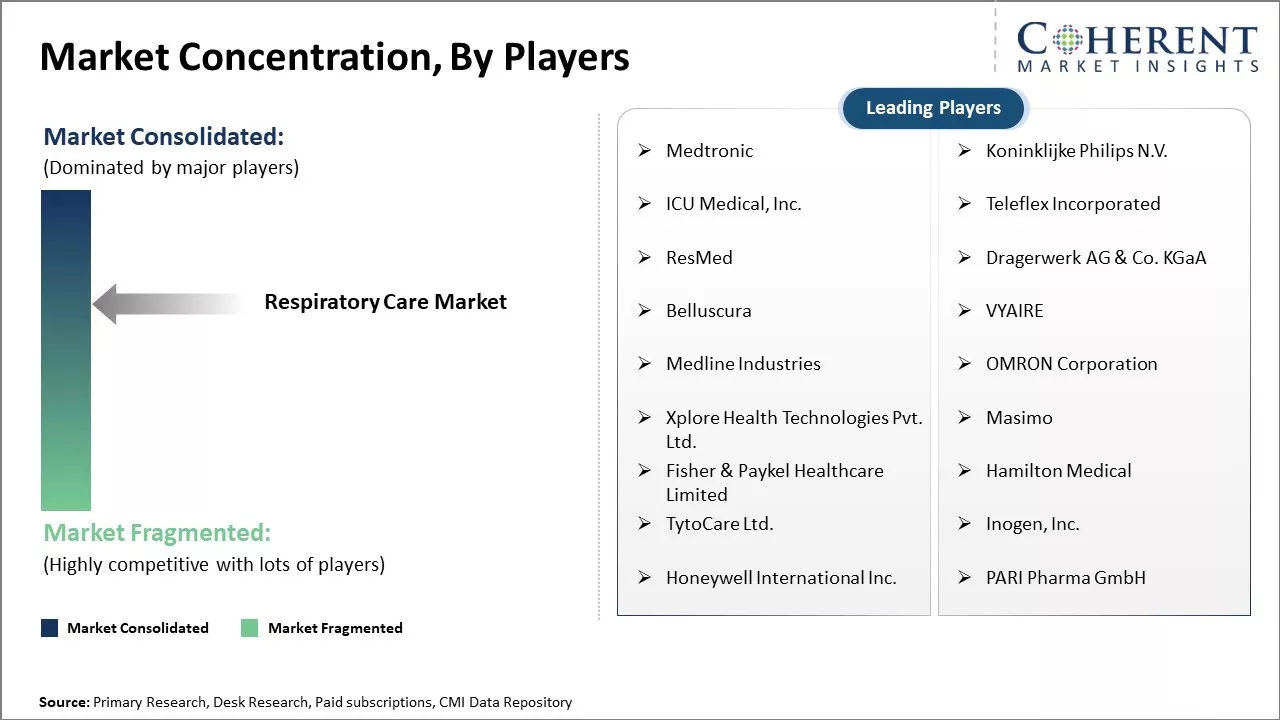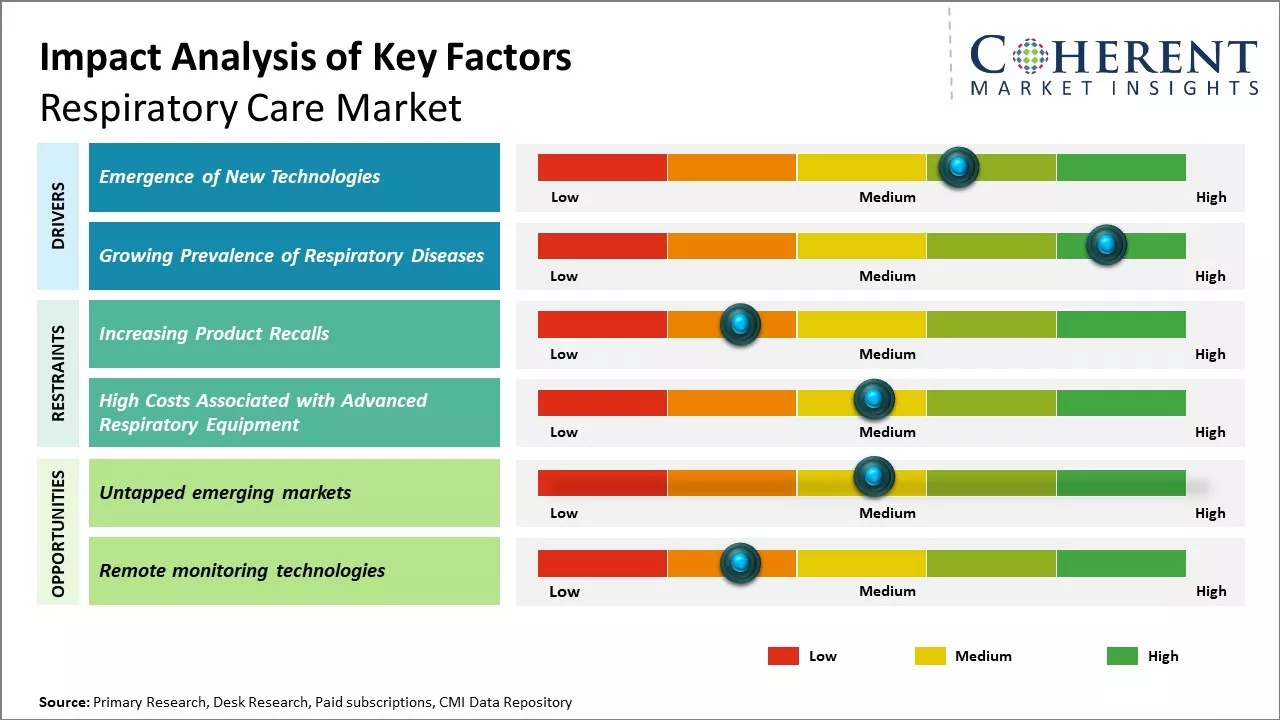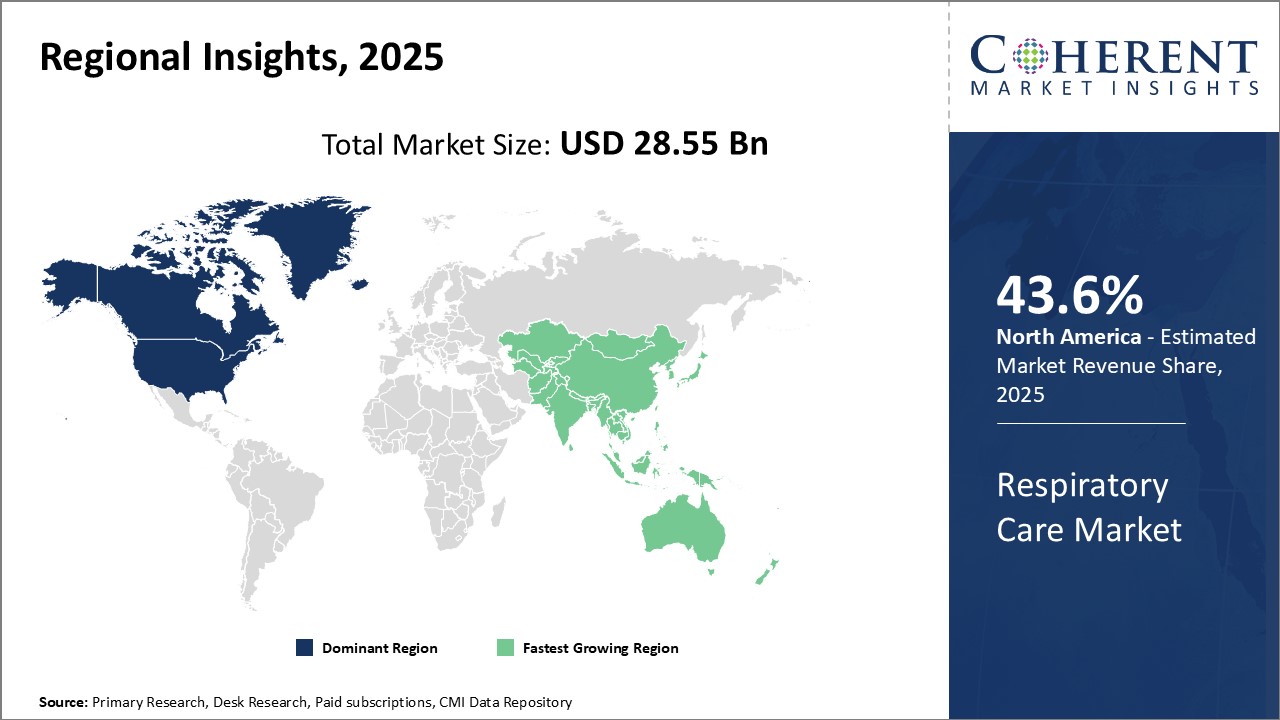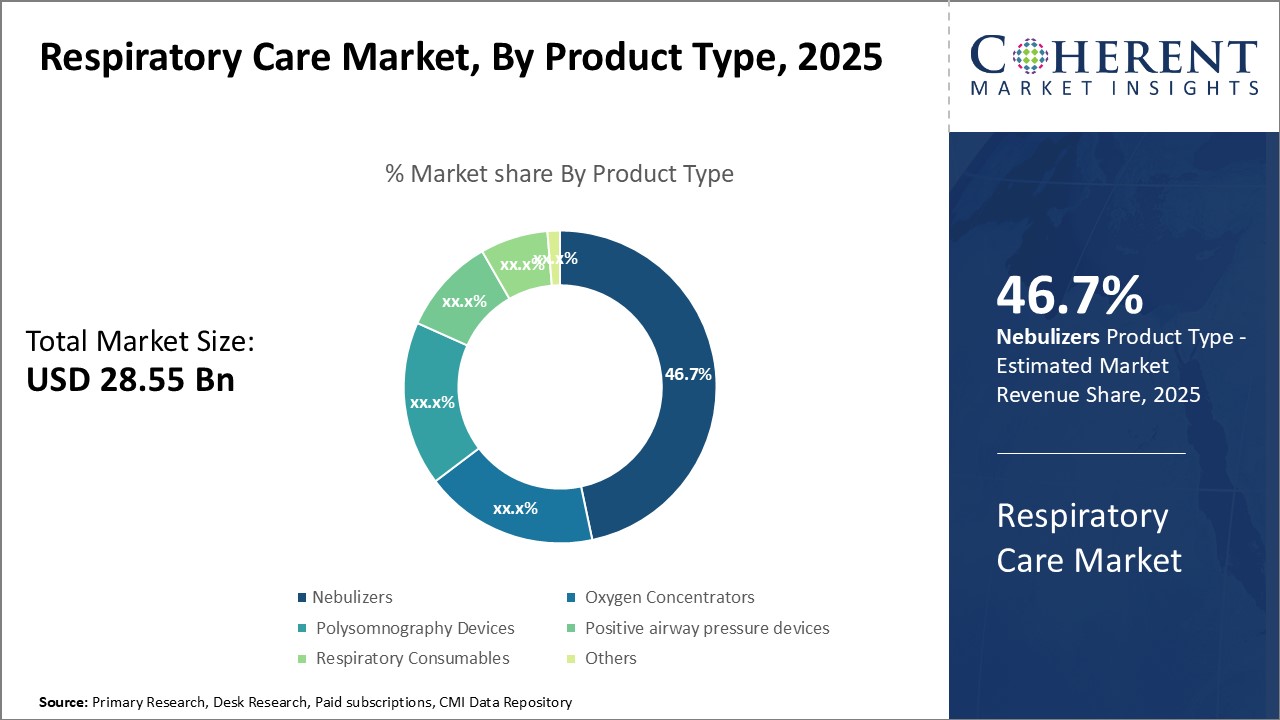Respiratory Care Market Size and Trends
The respiratory care market is estimated to be valued at USD 28.55 Bn in 2025 and is expected to reach USD 55.67 Bn by 2032, exhibiting a compound annual growth rate (CAGR) of 10.0% from 2025 to 2032.
Key Takeaways of the Global Respiratory Care Market
- By product type, the nebulizers segment is estimated to hold 46.7% share of the market in 2025.
- By indication, Chronic Obstructive Pulmonary Disease (COPD) sub-segment is expected to account for 34.2% of the market share in 2025.
- By end user, the hospitals sub-segment is expected to hold 34.4% of the market share in 2025.
- North America remains the dominant region in the global respiratory care market and is anticipated to hold 43.6% of the market share in 2025.
Market Overview
The global respiratory care market is projected to witness significant growth through 2032, driven by the increasing prevalence of chronic respiratory diseases such as COPD, asthma, and sleep apnea, along with the rising levels of air pollution and tobacco consumption. The growing elderly population and rising demand for advanced respiratory monitoring and therapeutic devices are further accelerating the market expansion.
Nebulizers continue to dominate the product segment, owing to their critical role in delivering medication directly to the lungs, particularly for patients with chronic respiratory conditions. The market is also witnessing the rising adoption of positive airway pressure (PAP) devices and oxygen concentrators, especially in home care settings, due to the increasing burden of sleep disorders and respiratory insufficiencies.
Hospitals remain the primary end users of respiratory care equipment due to the high volume of respiratory interventions and the availability of critical care infrastructure. However, demand is also growing across ambulatory surgical centers and homecare facilities, driven by the trend toward decentralized care.
North America leads the global respiratory care market, underpinned by a well-established healthcare system, strong reimbursement policies, and a high prevalence of respiratory disorders. Despite market opportunities, challenges such as device affordability, lack of awareness in developing regions, and limited access to advanced treatment continue to impede growth. Nonetheless, advancements in portable respiratory devices, tele-respiratory care, and AI-integrated diagnostics are set to reshape the market landscape in the coming years.
AI Impacts on the Respiratory Care Market
The respiratory care market is experiencing a technological evolution with the integration of artificial intelligence (AI), enhancing diagnostic accuracy, personalized therapy, and patient monitoring. AI-driven solutions are being used to analyze respiratory patterns, optimize ventilator settings, and predict exacerbations in chronic conditions like COPD and asthma. These advancements are improving clinical outcomes, reducing hospital readmissions, and supporting remote and home-based respiratory care.
- In June 2025, ResMed showcased its commitment to AI-driven PAP therapy with sessions highlighting “Using AI to explore patient experiences with healthcare providers in PAP therapy.”
- In September 2024, researchers published a study titled Machine learning‑based algorithms for at‑home respiratory disease monitoring and respiratory assessment. Using CPAP data, they demonstrated that ML models (e.g. random forests) could accurately classify breathing patterns for home-based monitoring.
- In October 2024, the SpiroActive initiative explored active learning to collect efficient training data for wearable spirometry. This ML-based solution supports more accurate, accessible spirometry through strategic data sampling.
Market Concentration and Competitive Landscape

To learn more about this report, Download Free Sample
- Leading players such as Medtronic, Koninklijke Philips N.V., ResMed, ICU Medical, Inc., Fisher & Paykel Healthcare Limited, and OMRON Corporation have established a dominant presence in the global respiratory care market. These companies benefit from diversified product portfolios, global distribution networks, and continuous innovation in respiratory diagnostics, ventilation, and homecare therapy. Their strategic investments in AI, connected devices, and tele-respiratory care solutions help maintain a competitive edge.
- The respiratory care market is moderately consolidated, with dominance by top-tier medical device companies; however, it also includes a wide array of regional and specialized firms such as Belluscura, TytoCare Ltd., and Xplore Health Technologies Pvt. Ltd. This blend of major global players and emerging innovators results in a dynamic competitive landscape. Market competition is shaped by factors such as regulatory approvals, homecare expansion, telemedicine integration, and partnerships with hospitals and healthcare systems.
- While large firms lead with scale and R&D capabilities, niche players contribute to innovation and localized service delivery, particularly in portable oxygen therapy, digital spirometry, and wearable respiratory monitoring, driving both collaboration and competition in the evolving respiratory care ecosystem.
Current Events and Their Impact on the Respiratory Care Market
|
Current Events |
Description and its impact |
|
Global Oxygen Supply Infrastructure Strengthening |
|
|
AI Integration in Respiratory Diagnostics and Monitoring |
|
Uncover macros and micros vetted on 75+ parameters: Get instant access to report

To learn more about this report, Download Free Sample
Market Trend
Growing Prevalence of Respiratory Diseases Driving Demand for Advanced Care Solutions
The global respiratory care market is witnessing robust growth fueled by the escalating prevalence of chronic respiratory diseases such as chronic obstructive pulmonary disease (COPD), asthma, and lung cancer. One of the most influential trends reshaping the market is the increasing global disease burden associated with these conditions, resulting in a heightened demand for therapeutic and diagnostic respiratory devices.
COPD, which includes chronic bronchitis and emphysema, remains one of the leading causes of morbidity and mortality worldwide. Asthma also poses a significant global health challenge. According to a World Health Organization fact sheet published in May 2023, approximately 262 million people were reported to be living with asthma globally. This rising incidence of respiratory ailments is translating into substantial demand for a wide range of respiratory care products, including oxygen concentrators, nebulizers, ventilators, and pulmonary diagnostics equipment.
The treatment and management of these disorders increasingly rely on inhaled drug delivery systems, such as metered dose inhalers (MDIs) and dry powder inhalers (DPIs), which are gaining widespread adoption due to their efficacy and ease of use. Moreover, pulmonary function tests (PFTs) are becoming a standard component of disease screening and monitoring, enabling early detection and tailored treatment pathways.
As the global healthcare ecosystem places more focus on chronic disease management and home-based care, the demand for innovative, portable, and connected respiratory care solutions is expected to rise sharply—shaping a future where proactive and personalized respiratory management becomes the norm.
Market Opportunity: Unlocking Growth Potential in Untapped Emerging Markets
Emerging markets such as Asia Pacific, Latin America, the Middle East, and Africa present significant growth opportunities for the global respiratory care market. These regions are characterized by a large and underserved patient population facing rising incidences of chronic respiratory diseases, largely driven by increasing urbanization, industrialization, pollution exposure, and lifestyle changes.
For example, according to the WHO data published in 2020, asthma-related deaths in Afghanistan reached 3,403, accounting for 1.47% of total deaths, while Bangladesh reported 8,893 asthma-related deaths (1.24% of total deaths). Additionally, a study published by the National Library of Medicine in March 2022 indicated that the prevalence of COPD in sub-Saharan Africa (SSA) ranged widely from 1.7% to 24.8%, highlighting a significant disease burden in the region.
As healthcare infrastructure continues to improve across these geographies, combined with rising disposable incomes, supportive government health initiatives, and greater awareness of respiratory conditions, the demand for respiratory care products is expected to surge. Furthermore, these regions offer attractive conditions for clinical trials, market expansion by pharmaceutical and medical device companies, and localized manufacturing initiatives.
With favorable demographics, high unmet clinical needs, and evolving healthcare policies, companies that prioritize expansion strategies in these untapped markets—particularly with cost-effective, portable, and digital respiratory solutions—stand to capture long-term market share and drive meaningful health outcomes across vulnerable populations.
Respiratory Care Market Insights by Product Type- Rise in Chronic Respiratory Diseases Drives Demand for Nebulizers
The nebulizers segment is projected to account for 46.7% of the global respiratory care market share in 2025, driven by the rising prevalence of chronic respiratory diseases such as asthma and chronic obstructive pulmonary disease (COPD).
Nebulizers are widely used for respiratory drug delivery, converting medications into a fine mist that can be inhaled directly into the lungs for quick relief. As COPD cases increase due to factors like smoking and air pollution, nebulizers are becoming essential for managing symptoms and reducing disease complications.
Their portability, ease of use, and suitability for home-based care make them especially valuable for long-term disease management. Continued innovation, including connected and battery-powered models, is expected to boost their adoption across both clinical and homecare settings—solidifying their role as a key growth driver in the respiratory care market.
Respiratory Care Market Insights by Indication- Rising Incidence of COPD Fuels the Market Growth
The indication segment includes Chronic Obstructive Pulmonary Disease (COPD), asthma, pneumonia, and others. The COPD sub-segment is projected to account for 34.2% of the global respiratory care market share in 2025, driven by its increasing prevalence and clinical impact.
COPD has emerged as a major global health concern, primarily due to exposure to cigarette smoke, air pollution, and occupational hazards. With over 300 million people affected worldwide, the demand for respiratory support devices such as oxygen concentrators, nebulizers, and non-invasive ventilators continues to grow.
As a chronic condition requiring long-term management, COPD is expected to remain a key contributor to the expansion of the respiratory care market.
Respiratory Care Market Insights by End User- Hospitals Segment Dominates with Critical Care Capabilities
The end user segment includes hospitals, ambulatory surgical centers, clinics, and others. The hospitals sub-segment is projected to account for 34.4% of the global respiratory care market share in 2025, driven by their central role in providing advanced respiratory treatment and emergency care.
Hospitals manage a wide range of respiratory conditions and are equipped with specialized infrastructure for ventilation therapy, IV drug administration, and pulmonary rehabilitation. As healthcare infrastructure expands, particularly in emerging regions, hospitals are seeing increased demand for respiratory care—supporting their position as a key growth driver in the market.
Regional Insights

To learn more about this report, Download Free Sample
North America Respiratory Care Market Analysis and Trends
North America is anticipated to hold a dominant 43.6% share of the global respiratory care market in 2025, driven by a high burden of chronic respiratory diseases such as COPD and asthma, along with a rapidly aging population in the U.S. and Canada.
The region’s leadership is supported by the presence of major industry players like Philips, ResMed, and BD, which continue to invest in R&D, innovation, and localized manufacturing. These companies have helped shape a robust product pipeline and ensure the availability of cutting-edge respiratory care solutions across clinical and home settings.
Well-established reimbursement frameworks in the U.S. and Canada also play a critical role, enhancing patient access to respiratory therapies and equipment. Furthermore, the increasing adoption of home-based respiratory care and supportive healthcare infrastructure continues to drive sustained demand for devices such as oxygen concentrators, CPAP machines, nebulizers, and ventilators, positioning North America as a global leader in respiratory care advancements.
Asia Pacific Respiratory Care Market Analysis and Trends
Asia Pacific is poised to be the fastest-growing regional market for respiratory care devices, driven by improving healthcare access, expanding medical infrastructure, and the rising prevalence of respiratory conditions in countries such as India, China, and Japan.
Rapid urbanization and air pollution have significantly increased the incidence of COPD and asthma, creating a strong demand for respiratory care solutions. In response, global manufacturers are setting up localized production facilities to better serve the region’s price-sensitive markets and enhance distribution efficiency.
With supportive government policies, rising healthcare spending, and increasing adoption of portable and home-based respiratory devices, Asia Pacific is expected to remain a major growth engine for the global respiratory care market through 2025 and beyond.
U.S. Respiratory Care Market Analysis and Trends
The U.S. respiratory care market is among the most advanced globally, driven by a high prevalence of chronic respiratory diseases, a strong healthcare infrastructure, and ongoing medical device innovation.
Rising cases of COPD, asthma, and sleep apnea, particularly among the aging population, continue to fuel demand for advanced respiratory care solutions. Leading companies such as ResMed, Philips, and BD are actively advancing technologies like portable oxygen concentrators, CPAP machines, and smart inhalers—with a growing emphasis on home-based and remote care.
Supportive reimbursement policies and federal initiatives aimed at improving respiratory health further reinforce market growth. With high rates of treatment adoption and technology integration, the U.S. is expected to maintain its leadership position in the global respiratory care market through 2025.
Pricing Analysis of the Respiratory Care Market
|
Category
|
Description |
Typical Pricing Range (USD) |
Example Use Case |
|
1. Equipment Pricing |
|
|
|
|
a) Nebulizers |
Common for asthma/COPD drug delivery. Pricing varies based on type (jet, ultrasonic, mesh). |
US$ 30 – US$ 150 per unit |
A patient purchasing a mid-range mesh nebulizer might spend ~US$ 100. |
|
b) Oxygen Concentrators |
Key for chronic respiratory conditions and post-COVID oxygen therapy. |
US$ 300 – US$ 1,800 per unit (home-use) |
A home-based user may buy a portable concentrator for ~US$ 800. |
|
2. Consumables and Accessories |
|
|
|
|
a) Masks and Tubing (CPAP/BiPAP) |
Requires regular replacement (every 3–6 months). |
US$ 20 – US$ 100 per set |
A patient replacing mask and tubing every 6 months may spend ~US$ 150 annually. |
|
b) Respiratory Consumables |
Includes filters, spacers, chambers, and humidification systems. |
US$ 10 – US$ 50 per item |
Hospitals order filters in bulk for use with ventilators and concentrators. |
|
3. Service and Maintenance |
|
|
|
|
a) Device Servicing & Repair |
Annual maintenance for devices (oxygen concentrators, ventilators, etc.). |
US$ 100 – US$ 500 per service cycle |
A home user may pay US$ 150/year for concentrator servicing. |
|
b) Hospital Ventilator Maintenance |
Professional-grade ICU ventilators require certified periodic servicing. |
US$ 1,000 – US$ 3,000 per year |
A hospital may budget ~US$ 2,000 annually per unit. |
Uncover macros and micros vetted on 75+ parameters: Get instant access to report
Market Report Scope
Respiratory Care Market Report Coverage
| Report Coverage | Details | ||
|---|---|---|---|
| Base Year: | 2024 | Market Size in 2025: | USD 28.55 Bn |
| Historical Data for: | 2020 To 2024 | Forecast Period: | 2025 To 2032 |
| Forecast Period 2025 to 2032 CAGR: | 10% | 2032 Value Projection: | USD 55.67 Bn |
| Geographies covered: |
|
||
| Segments covered: |
|
||
| Companies covered: |
Medtronic, Koninklijke Philips N.V., ICU Medical, Inc., Teleflex Incorporated, ResMed, Dragerwerk AG & Co. KGaA, Belluscura, VYAIRE, Medline Industries, OMRON Corporation, Xplore Health Technologies Pvt. Ltd., Masimo, Fisher & Paykel Healthcare Limited, Hamilton Medical, TytoCare Ltd., Inogen, Inc., Honeywell International Inc., and PARI Pharma GmbH |
||
| Growth Drivers: |
|
||
| Restraints & Challenges: |
|
||
Uncover macros and micros vetted on 75+ parameters: Get instant access to report
Respiratory Care Industry News
- In February 2024, ResMed, launched its AirCurve 11 series devices, the company’s newest bilevel devices that use two levels of support, inspiratory positive airway pressure (IPAP) and expiratory positive airway pressure (EPAP), combined with digital technology to make it easier for healthcare providers to treat sleep apnea and help patients start and stay on therapy. AirCurve 11 devices are built on ResMed’s market-leading AirSense 11 platform and enhance the suite of offerings available for healthcare providers and clinicians when determining the best care for sleep apnea patients.
- In February 2024, Getinge launched its Servo-c mechanical ventilator in India. The Servo-c is designed to address patients’ respiratory needs, offering lung-protective therapeutic tools. Through this launch, the company wants to make healthcare solutions accessible and affordable to hospitals in India.
Analyst View
- The global respiratory care market is at a transformative inflection point, propelled by the escalating prevalence of chronic respiratory conditions such as COPD, asthma, and sleep apnea, along with rising air pollution and tobacco use. With increasing demand for both acute and long-term respiratory support, the market is shifting from traditional hospital-based delivery models to home-centric, connected care ecosystems.
- Technological innovation is a key enabler of this evolution. Advanced respiratory devices such as smart inhalers, AI-integrated ventilators, and cloud-connected CPAP machines are redefining treatment personalization and remote monitoring. These solutions are gaining traction among healthcare providers and patients alike, driven by the global push for decentralized care, reduced hospitalizations, and improved therapy adherence.
- Regionally, North America remains the market leader due to its robust healthcare infrastructure, favorable reimbursement frameworks, and early adoption of digital health tools. However, Asia Pacific is emerging as the most dynamic growth region, driven by rising respiratory disease incidence, improving healthcare access, urbanization, and the increasing affordability of respiratory devices. The region is also witnessing a surge in localized manufacturing and public-private collaborations aimed at scaling access to oxygen and essential care technologies.
- From an innovation standpoint, AI is playing an increasingly pivotal role in shaping the respiratory care landscape. Machine learning algorithms are being leveraged for predictive diagnostics, therapy optimization, and efficient data capture via wearable spirometers and connected monitoring platforms. These advances are streamlining clinical decision-making, reducing readmissions, and improving patient engagement, especially in chronic disease management.
- The competitive landscape is becoming increasingly hybrid—with leading players like Philips, ResMed, Medtronic, and Fisher & Paykel focusing on R&D, acquisitions, and digital integration, while emerging startups and regional firms are contributing to niche innovations in portable oxygen therapy, mobile respiratory diagnostics, and AI-powered care delivery. The convergence of respiratory therapy, telemedicine, and digital therapeutics will continue to blur boundaries, creating new value pools and business models.
- Looking forward, market growth will be underpinned by three pillars: the increasing global burden of respiratory diseases, advancements in AI-enabled devices, and expansion into underserved and emerging markets. Companies that can deliver cost-effective, connected, and patient-friendly respiratory care solutions are well-positioned to lead the next wave of growth in this critical segment of global healthcare.
Market Segmentation
- Product Type Insights (Revenue, USD Bn, 2020 - 2032)
- Nebulizers
- Oxygen Concentrators
- Polysomnography Devices
- Positive airway pressure devices
- Respiratory Consumables
- Others
- Indication Insights (Revenue, USD Bn, 2020 - 2032)
- Chronic Obstructive Pulmonary Disease (COPD)
- Asthma
- Pneumonia
- Others
- End User Insights (Revenue, USD Bn, 2020 - 2032)
- Hospitals
- Ambulatory Surgical Centers
- Clinics
- Others
- Regional Insights (Revenue, USD Bn, 2020 - 2032)
- North America
- U.S.
- Canada
- Latin America
- Brazil
- Argentina
- Mexico
- Rest of Latin America
- Europe
- Germany
- U.K.
- Spain
- France
- Italy
- Russia
- Rest of Europe
- Asia Pacific
- China
- India
- Japan
- Australia
- South Korea
- ASEAN
- Rest of Asia Pacific
- Middle East
- GCC Countries
- Israel
- Rest of Middle East
- Africa
- South Africa
- North Africa
- Central Africa
- Key Players Insights
- Medtronic
- Koninklijke Philips N.V.
- ICU Medical, Inc.
- Teleflex Incorporated
- ResMed
- Dragerwerk AG & Co. KGaA
- Belluscura
- VYAIRE
- Medline Industries
- OMRON Corporation
- Xplore Health Technologies Pvt. Ltd.
- Masimo
- Fisher & Paykel Healthcare Limited
- Hamilton Medical
- TytoCare Ltd.
- Inogen, Inc.
- Honeywell International Inc.
- PARI Pharma GmbH
Sources
Stakeholders:
- Respiratory Device Manufacturers (e.g., ResMed, Philips, Fisher & Paykel)
- Hospitals, Pulmonology Clinics, and Critical Care Centers
- Durable Medical Equipment (DME) Distributors and Home Healthcare Providers
- Regulatory and Public Health Bodies (e.g., WHO, FDA, CDSCO)
- Telehealth and Remote Respiratory Monitoring Companies
- AI & Digital Health Startups in Pulmonary Care
- Oxygen Infrastructure and Gas Supply Chain Vendors
Primary Sources:
- Interviews with Respiratory Therapists, ICU Physicians, Procurement Heads (2023–2025)
- Public disclosures and press releases by manufacturers on product launches and trials
- Site-level case studies from hospitals and homecare agencies on device deployment
- Real-world insights from events such as ATS, ERS, MEDICA, and Arab Health
Secondary Sources:
- Company investor presentations, FDA 510(k) filings, and product brochures
- Publications from industry media: MedTech Dive, BioWorld, MobiHealthNews, RT Magazine
- Market trend reports from WHO, Global Asthma Report, GOLD Initiative, and NIH
- Whitepapers and webinars from medical device associations and respiratory societies
- Regional health ministry portals (e.g., India’s PM CARES, NHS oxygen strategy)
Proprietary Elements:
- CMI Data Analytics Tool, Proprietary CMI Existing Repository of information for last 8 years
*Definition: Respiratory care encompasses various aspects of medical care related to respiratory health. Respiratory devices are medical devices that are used to assist a patient suffering from breathing problems. These devices are used in the management and treatment of disorders such as fibrosis, asthma, Chronic Obstructive Pulmonary Disease (COPD), and others. There are a variety of diseases that benefit from these advanced tools such as oxygen concentrators, nebulizers, ventilators, etc. The respiratory device assists with the removal of mucus from the airways and improves pulmonary functions.
Share
Share
About Author
Komal Dighe is a Management Consultant with over 8 years of experience in market research and consulting. She excels in managing and delivering high-quality insights and solutions in Health-tech Consulting reports. Her expertise encompasses conducting both primary and secondary research, effectively addressing client requirements, and excelling in market estimation and forecast. Her comprehensive approach ensures that clients receive thorough and accurate analyses, enabling them to make informed decisions and capitalize on market opportunities.
Missing comfort of reading report in your local language? Find your preferred language :
Transform your Strategy with Exclusive Trending Reports :
Frequently Asked Questions
EXISTING CLIENTELE
Joining thousands of companies around the world committed to making the Excellent Business Solutions.
View All Our Clients

